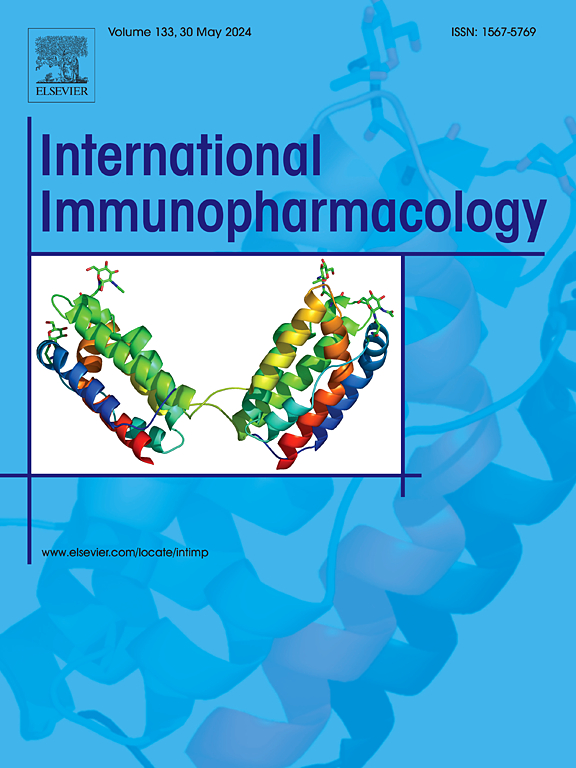气溶胶吸入rhIL-10通过中性粒细胞-血小板聚集影响肺中性粒细胞表型,改善小鼠急性肺损伤。
IF 4.8
2区 医学
Q2 IMMUNOLOGY
引用次数: 0
摘要
本研究探讨了重组人IL-10 (rhIL-10)通过气溶胶吸入治疗急性肺损伤(ALI)的效果,特别关注中性粒细胞。它探讨了在血小板存在下rhIL-10如何调节中性粒细胞极化以改善急性肺损伤。最初,在小鼠中建立的ALI模型表明,气溶胶吸入rhIL-10可显著减轻肺部细胞因子风暴,减轻肺水肿,减轻肺组织的组织病理学损伤。此外,研究发现rhIL-10可以减少小鼠肺部的中性粒细胞浸润和血小板活化,抑制血小板-中性粒细胞聚集体(PNAs)的形成,并在血小板存在的情况下促进中性粒细胞向抗炎表型分化。随后,从小鼠骨髓和血液中分离出原代中性粒细胞和血小板,以探索其潜在的机制。结果表明,rhIL-10可促进中性粒细胞中信号转导和转录激活因子3 (STAT3)和细胞因子信号传导抑制因子3 (SOCS3)的表达,抑制核因子κB (NF-κB)和NF-κB抑制剂(i -κB)的激活,从而增强CD40的表达。这种相互作用促进PNAs的形成并影响中性粒细胞表型分化。此外,STAT3磷酸化抑制剂statstatic和CD40抗体在体内的应用进一步验证了这一潜在机制。综上所述,这些结果表明,气溶胶吸入rhIL-10可有效改善ALI。其潜在机制可能涉及中性粒细胞STAT/SOCS-IκB/NF-κB-CD40信号通路的调节,促进中性粒细胞和血小板之间的相互作用,从而促进中性粒细胞向抗炎表型分化。本文章由计算机程序翻译,如有差异,请以英文原文为准。

Aerosol inhalation of rhIL-10 improves acute lung injury in mice by affecting pulmonary neutrophil phenotypes through neutrophil-platelet aggregates
This study investigates the therapeutic effects of recombinant human IL-10 (rhIL-10) administered via aerosol inhalation in acute lung injury (ALI), with a particular focus on neutrophils. It explores how rhIL-10, in the presence of platelets, modulates neutrophil polarization to ameliorate acute lung injury. Initially, the ALI model established in mice demonstrated that aerosol inhalation of rhIL-10 significantly mitigated the cytokine storm in the lungs, reduced pulmonary edema, and alleviated histopathological damage to lung tissue. Additionally, rhIL-10 administration was found to decrease neutrophil infiltration and platelet activation in the lungs of mice, inhibiting the formation of platelet-neutrophil aggregates (PNAs) and promoting the differentiation of neutrophils toward an anti-inflammatory phenotype in the presence of platelets. Subsequently, primary neutrophils and platelets were isolated from mouse bone marrow and blood to explore the underlying mechanisms. The results indicated that rhIL-10 promotes the expression of the signal transducer and activator of transcription 3 (STAT3) and the suppressor of cytokine signaling 3 (SOCS3) in neutrophils while inhibiting the activation of the nuclear factor kappa B (NF-κB) and the NF-κB inhibitor (IκB), which in turn enhances CD40 expression. This interaction facilitates the formation of PNAs and influences neutrophil phenotype differentiation. Furthermore, the application of the STAT3 phosphorylation inhibitor Stattic and CD40 antibody in vivo provided further validation of this potential mechanism. In conclusion, these results indicate that aerosol inhalation of rhIL-10 effectively ameliorates ALI. The underlying mechanism may involve the modulation of the neutrophil STAT/SOCS-IκB/NF-κB-CD40 signaling pathway, promoting interactions between neutrophils and platelets that facilitate the differentiation of neutrophils toward an anti-inflammatory phenotype.
求助全文
通过发布文献求助,成功后即可免费获取论文全文。
去求助
来源期刊
CiteScore
8.40
自引率
3.60%
发文量
935
审稿时长
53 days
期刊介绍:
International Immunopharmacology is the primary vehicle for the publication of original research papers pertinent to the overlapping areas of immunology, pharmacology, cytokine biology, immunotherapy, immunopathology and immunotoxicology. Review articles that encompass these subjects are also welcome.
The subject material appropriate for submission includes:
• Clinical studies employing immunotherapy of any type including the use of: bacterial and chemical agents; thymic hormones, interferon, lymphokines, etc., in transplantation and diseases such as cancer, immunodeficiency, chronic infection and allergic, inflammatory or autoimmune disorders.
• Studies on the mechanisms of action of these agents for specific parameters of immune competence as well as the overall clinical state.
• Pre-clinical animal studies and in vitro studies on mechanisms of action with immunopotentiators, immunomodulators, immunoadjuvants and other pharmacological agents active on cells participating in immune or allergic responses.
• Pharmacological compounds, microbial products and toxicological agents that affect the lymphoid system, and their mechanisms of action.
• Agents that activate genes or modify transcription and translation within the immune response.
• Substances activated, generated, or released through immunologic or related pathways that are pharmacologically active.
• Production, function and regulation of cytokines and their receptors.
• Classical pharmacological studies on the effects of chemokines and bioactive factors released during immunological reactions.

 求助内容:
求助内容: 应助结果提醒方式:
应助结果提醒方式:


